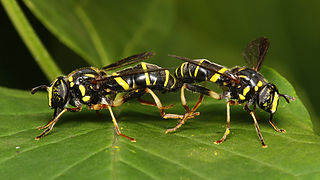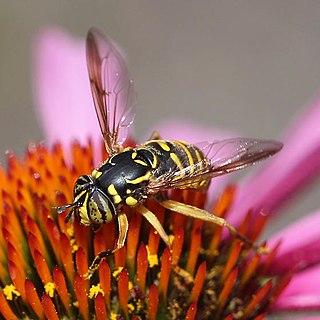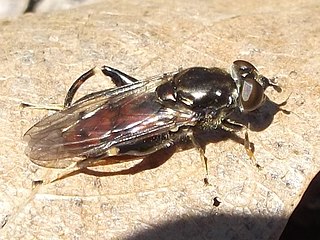
Hover flies, also called flower flies or syrphid flies, make up the insect family Syrphidae. As their common name suggests, they are often seen hovering or nectaring at flowers; the adults of many species feed mainly on nectar and pollen, while the larvae (maggots) eat a wide range of foods. In some species, the larvae are saprotrophs, eating decaying plant and animal matter in the soil or in ponds and streams. In other species, the larvae are insectivores and prey on aphids, thrips, and other plant-sucking insects.

Spilomyia is a genus of hoverflies. Many species in the genus show Batesian mimicry of wasp models, including black and yellow patterns and modified antenna shape.

Spilomyia sayi, the Four-lined Hornet Fly, is a fairly common species of syrphid fly. This species is found from western Canada to northeastern North America. Hoverflies get their names from the ability to remain nearly motionless while in flight. The adults are also known as flower flies for they are commonly found around and on flowers, from which they get both energy-giving nectar and protein-rich pollen. The larvae are known as the short-tailed larvae, suited for moist areas such as rot holes of trees. It is a wasp mimic.

The Milesiini is a large and diverse tribe of hoverflies. They mimic wasps or hornets.
Milesiina is a subtribe of syrphid flies in the family Syrphidae. There are at least 14 described species in Milesiina.

Spilomyia citima, the Western Hornet Fly, is a rare species of syrphid fly first officially described by Vockeroth in 1958. Hoverflies get their names from the ability to remain nearly motionless while in flight. The adults are also known as flower flies for they are commonly found around and on flowers, from which they get both energy-giving nectar and protein-rich pollen. The larvae are known as the short-tailed larvae suited for moist areas such as rot holes of trees.

Somula is a genus of syrphid flies in the family Syrphidae. There are at least two described species in Somula.
Spilomyia crandalli, Crandall's Hornet Fly, is a rare species of syrphid fly first officially described by Curran in 1951. This species is found in western North America near the Pacific coast. Hoverflies get their names from the ability to remain nearly motionless while in flight. The adults are also known as flower flies for they are commonly found around and on flowers, from which they get both energy-giving nectar and protein-rich pollen. The larvae are known as the short-tailed larvae, suited for moist areas such as rot holes of trees.

'Spilomyia fusca , the Bald-faced Hornet Fly, is a fairly common species of syrphid fly first officially described by Loew, 1864 This species is found in North Eastern America. Hoverflies get their names from the ability to remain nearly motionless while in flight. The adults are also known as flower flies for they are commonly found around and on flowers from which they get both energy-giving nectar and protein rich pollen. The larvae are known as the short-tailed larva taylored for moist areas such as rot holes of trees.

Sphecomyia is a genus of hoverfly in the family Syrphidae. There are about 16 described species in Sphecomyia.
Criorhina bubulcus'is a species of syrphid fly in the family Syrphidae.

Spilomyia alcimus, the Broad-banded Hornet Fly, is an uncommon species of syrphid fly first officially described by Walker in 1849. Hoverflies get their names from the ability to remain nearly motionless while in flight. The adults are also known as flower flies for they are commonly found around and on flowers, from which they get both energy-giving nectar and protein-rich pollen. The larvae are known as the short-tailed larvae suited for moist areas such as rot holes of trees.
Spilomyia kahli is a species of syrphid fly in the family Syrphidae.

Chalcosyrphus (Xylotomima) libo, the Long-haired Leafwalker, is an uncommon species of syrphid fly observed in north-central North America. Hoverflies are able to remain nearly motionless in flight. The adults are also known as flower flies for they are commonly found around and on flowers, from which they get both energy-giving nectar and protein-rich pollen.

Chalcosyrphus (Xylotomima) piger, the short-haired leafwalker, is an uncommon species of syrphid fly found throughout North America and Europe. Hoverflies get their names from the ability to remain nearly motionless while in flight. The adults are also known as flower flies, for they are commonly found around and on flowers, from which they get both energy-giving nectar and protein-rich pollen. Larvae have been identified from sappy hollows from Larix and Pinus.
Spilomyia pleuralis is a species of Hoverfly in the family Syrphidae.
Spilomyia ephippium is a species of Hoverfly in the family Syrphidae.
Xylota willistoni is a species of hoverfly in the family Syrphidae.
Total of 245 species either found or highly expected to be found in New York.










